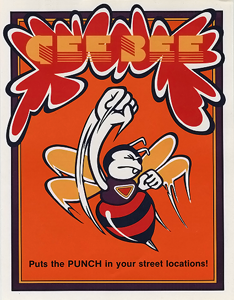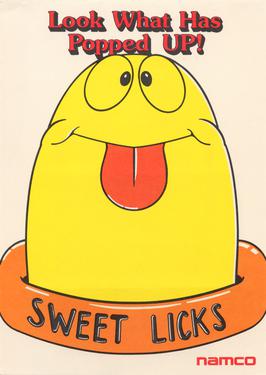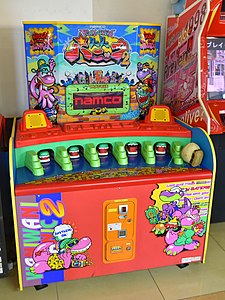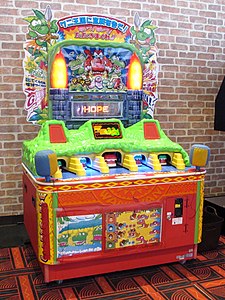
Namco Limited was a Japanese multinational video game and entertainment company, headquartered in Ōta, Tokyo. It held several international branches, including Namco America in Santa Clara, California, Namco Europe in London, Namco Taiwan in Kaohsiung, and Shanghai Namco in mainland China.

Whac-A-Mole is an arcade game. It was created in 1975 by the amusements manufacturer TOGO in Japan, where it was originally known as Mogura Taiji or Mogura Tataki.

Klonoa is a platform video game series created by Namco in 1997. It stars Klonoa, an anthropomorphic creature who explores dream worlds. The series includes two main games: Klonoa: Door to Phantomile (1997) for the PlayStation and Klonoa 2: Lunatea's Veil (2001) for the PlayStation 2. A remake of Door to Phantomile was released for the Wii in 2008, and remasters of both games were released in 2022. The series also includes a set of handheld games released between 1999 and 2002 for the WonderSwan and Game Boy Advance.

Banpresto Co., Ltd. was a Japanese video game developer and publisher headquartered in Shinagawa, Tokyo. It had a branch in Hong Kong named Banpresto H.K., which was headquartered in the New Territories. Banpresto was a partly-owned subsidiary of toymaker Bandai from 1989 to 2006, and a wholly-owned subsidiary of Bandai Namco Holdings from 2006 to 2008. In addition to video games, Banpresto produced toys, keyrings, apparel, and plastic models.

Rally-X is a maze chase arcade video game developed in Japan and Germany by Namco and released in 1980. In North America, it was distributed by Midway Manufacturing and in Europe by Karateco. Players drive a blue Formula One race car through a multidirectional scrolling maze to collect yellow flags. Boulders block some paths and must be avoided. Red enemy cars pursue the player in an attempt to collide with them. Red cars can be temporarily stunned by laying down smoke screens at the cost of fuel. Rally-X is one of the first games with bonus stages and continuously-playing background music.

Pac-Attack, also known as Pac-Panic, is a 1993 falling-tile puzzle video game developed and published by Namco for the Super Nintendo Entertainment System and Sega Genesis. Versions for the Game Boy, Game Gear and Philips CD-i were also released. The player is tasked with clearing out blocks and ghosts without them stacking to the top of the playfield — blocks can be cleared by matching them in horizontal rows, while ghosts can be cleared by placing down a Pac-Man piece that can eat them. It is the first game in the Pac-Man series to be released exclusively for home platforms.
Namco Museum is a series of video game compilations developed and published by Bandai Namco Entertainment for home video game consoles. The first title in the series, Namco Museum Vol. 1, was released for the PlayStation in 1995. Entries in the series have been released for multiple platforms, including the Game Boy Advance, PlayStation 2, PlayStation Portable, Nintendo DS and Xbox 360. the latest being Namco Museum Archives Vol. 2, released in 2020.

Toy Pop is a multidirectional shooter arcade game that was released by Namco in 1986. The game was later rereleased as part of Namco Museum Vol. 1 for the original Sony PlayStation in 1995.

Gee Bee is a block breaker/video pinball hybrid arcade game developed and published by Namco in 1978. The player controls a set of paddles with a rotary knob, with the objective being to score as many points as possible by deflecting a ball against bricks, pop bumpers and other objects in the playfield. It was developed by Toru Iwatani, known as the creator of Pac-Man and Pole Position. Outside Japan, it was published by Gremlin Industries.

Bomb Bee is a Japanese arcade game that was released by Namco in 1979. It is the sequel to Gee Bee, which was released in the previous year.

Cutie Q is a 1979 block breaker/video pinball hybrid arcade game developed and published by Namco in Japan. The player controls a set of paddles with a rotary knob, the objective being to score as many points possible by deflecting a ball against blocks, ghosts, spinners and other objects on the playfield. It was designed by Shigeru Yokoyama, with spritework done by Toru Iwatani. It is the third and final game in the Gee Bee trilogy.

Taiko no Tatsujin is a video game series created by Namco. In the games, players simulate playing a taiko drum in time with music. The series has released games for the arcade and for console and mobile platforms including PlayStation 2, Advanced Pico Beena, PlayStation Portable, Nintendo DS, Wii, Nintendo 3DS, Wii U, PlayStation Vita, PlayStation 4, Nintendo Switch, Xbox One, Xbox Series X/S, Microsoft Windows, iOS, Android and Japanese feature phones.

Bandai Namco Entertainment Inc. is a Japanese multinational video game publisher owned by Bandai Namco Holdings. It was founded in 2006 as Namco Bandai Games Inc., following the 2005 merger of Namco and Bandai. Namco acquired Bandai's video game business division through a corporate split. In 2009, Bandai Namco Games absorbed Bandai Networks. It is headquartered in Minato, Tokyo.

Kidō Senshi Gundam: Senjō no Kizuna, is a Japanese arcade game set in the original Gundam universe. The game was created by Bandai Namco and Banpresto and was released late 2006. Play involves stepping into a P.O.D. and doing battle with other players across Japan.

Namco Museum Remix is a 2007 video game compilation developed and published for the Wii by Namco Bandai Games. The compilation includes nine Namco arcade games and five "remix" games made specifically for this compilation. A remake, Namco Museum Megamix, was released exclusively in North America on November 26, 2010; the game features nine other arcade games alongside the titles from the original, as well as an additional remix game based on Grobda.

Namco Museum DS is a 2007 video game compilation developed by M2 and published by Namco Bandai Games. The game features 7 arcade games previously published by Namco along with a Nintendo DS version of the Nintendo-developed title Pac-Man Vs.

Namco Generations was a brand name created by Namco Bandai Games for modernized remakes of their older video games. It was introduced in 2010 in conjunction with Pac-Man Championship Edition DX for the Xbox 360 and PlayStation 3. Galaga Legions DX was the second game to use the brand, being released in 2011. Two other games were in production under the Namco Generations label, a Metro-Cross sequel named Aero-Cross and a remaster of Dancing Eyes, both of which were cancelled.

Bandai Namco Studios Inc. is a Japanese video game developer headquartered in Kōtō, Tokyo. Its offices in Malaysia and Singapore, Bandai Namco Studio Malaysia and Bandai Namco Studios Singapore, are based out of Selangor, Malaysia and Infinite Studios, Singapore respectively. Bandai Namco Studios is a subsidiary of Bandai Namco Entertainment, which itself is a subsidiary of Bandai Namco Holdings. The company works under its parent company as a keiretsu; Bandai Namco Studios creates video games for home consoles, handheld systems, mobile devices and arcade hardware, while Bandai Namco Entertainment handles the managing, marketing and publishing of these products.
B.B. Studio Co., Ltd. is a Japanese video game development company. The company is a result of a merger between BEC and Banpresoft by their parent company, Bandai Namco Entertainment.

Sweet Licks, known as Okashi Daisakusen in Japan and Choco-Kid in Europe, is a 1981 coin-operated redemption mole-buster arcade game developed and published by Namco. Players use a foam-covered mallet to whack the eight "Pyokotan" cake monsters that emerge from the colored holes placed on the machine. Points are awarded for hitting them, and the speed of the game increases until the time limit runs out. Hitting 40 Pyokotan will increase the timer by 15 seconds.




















